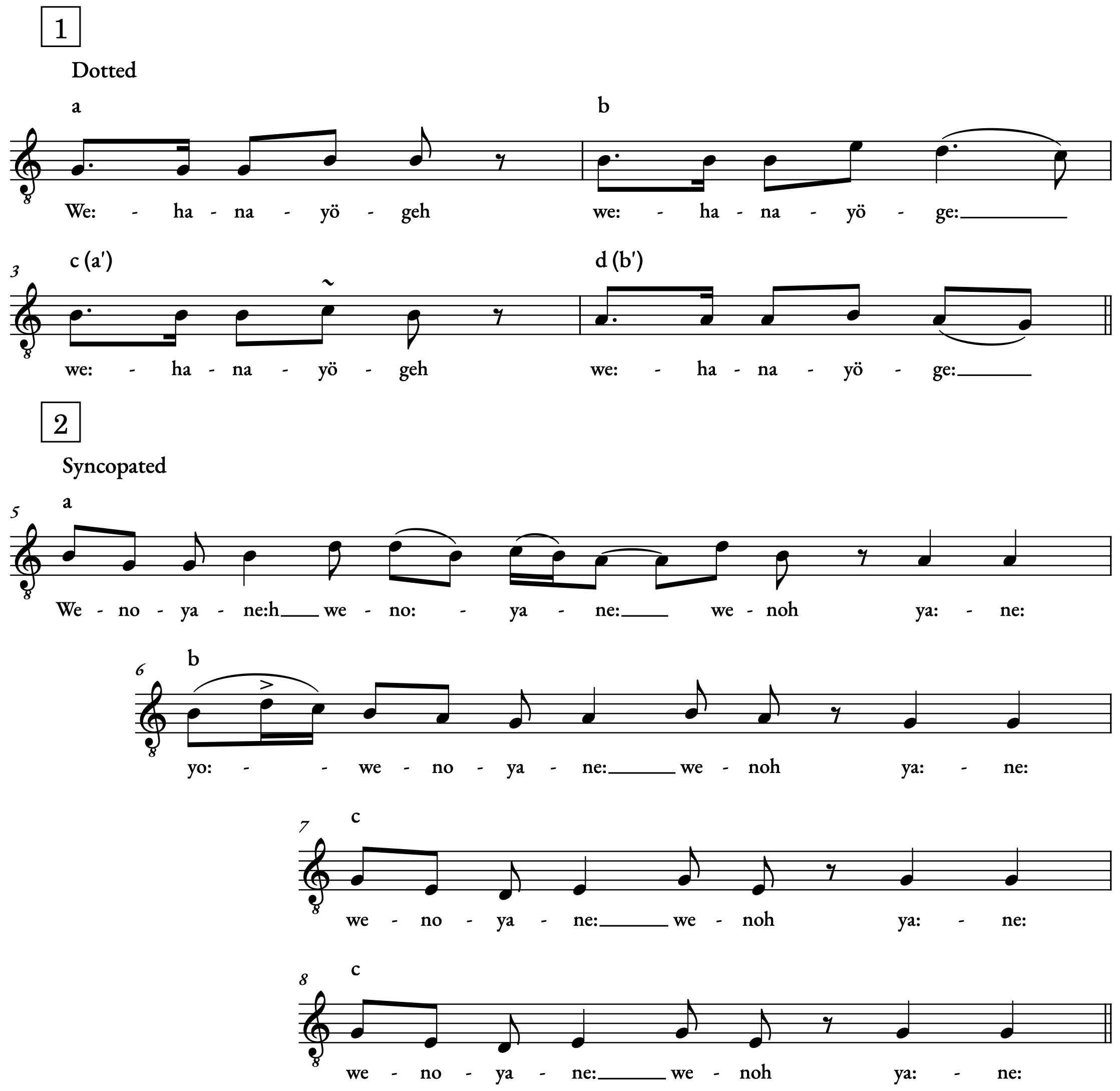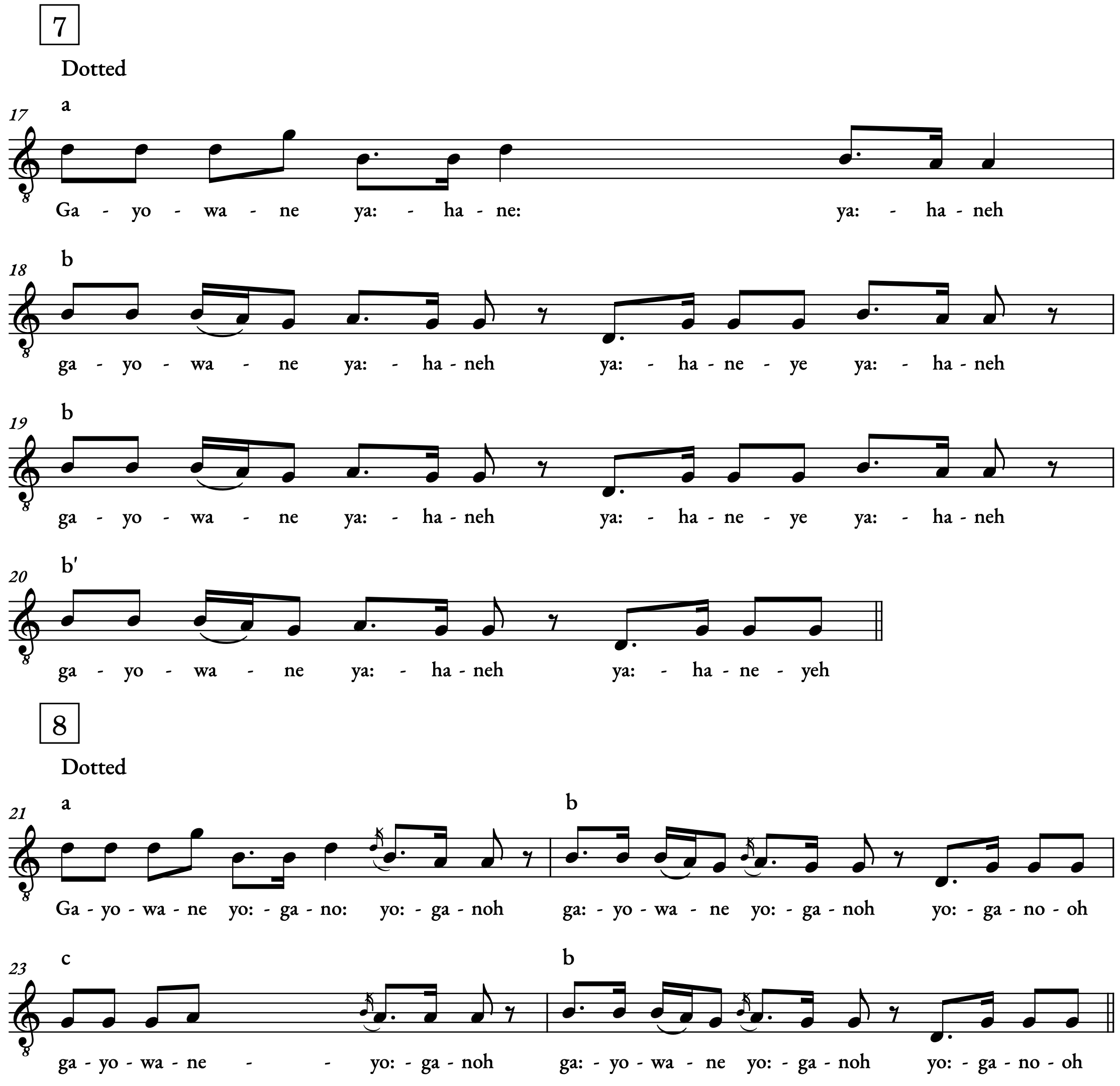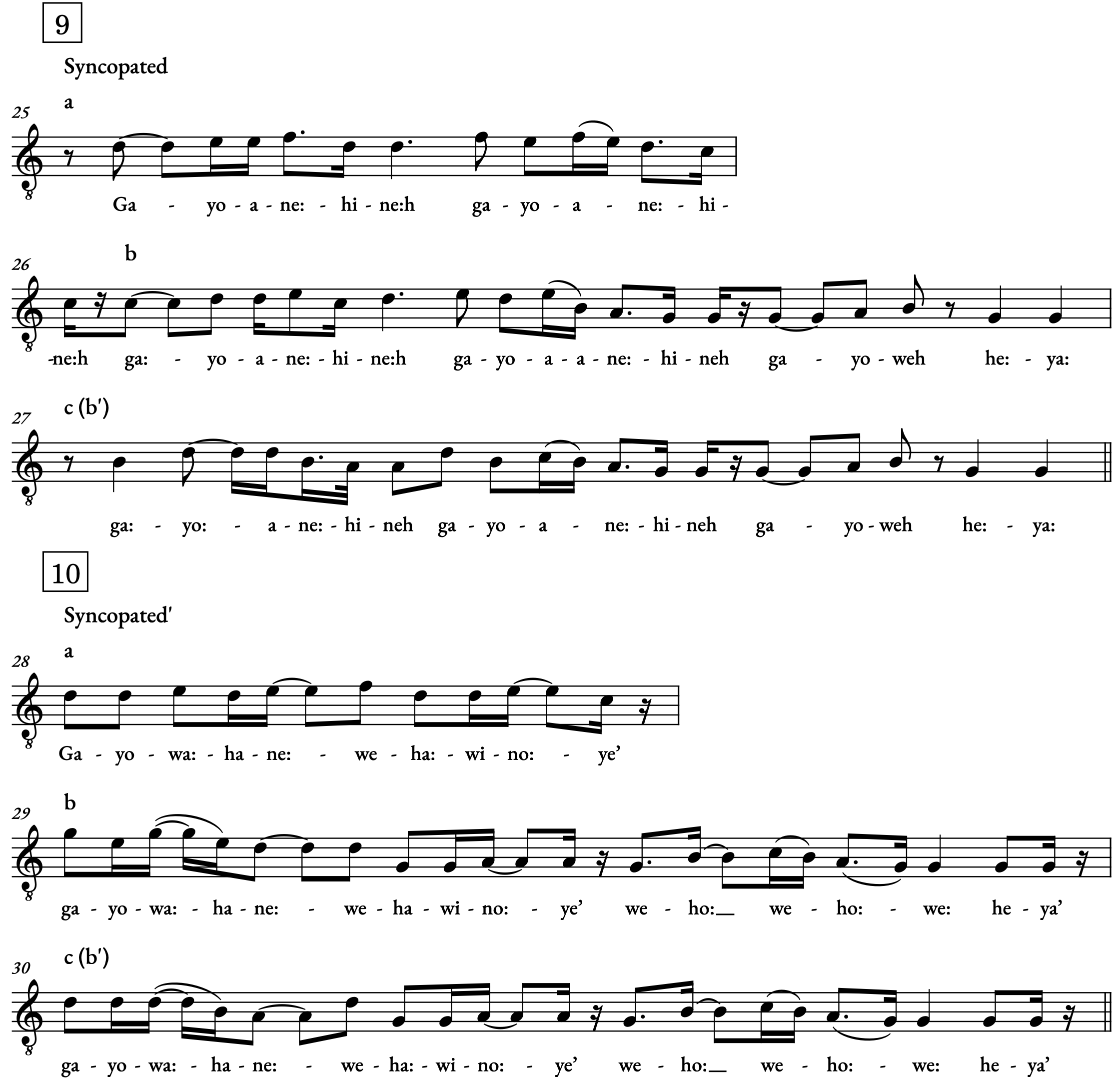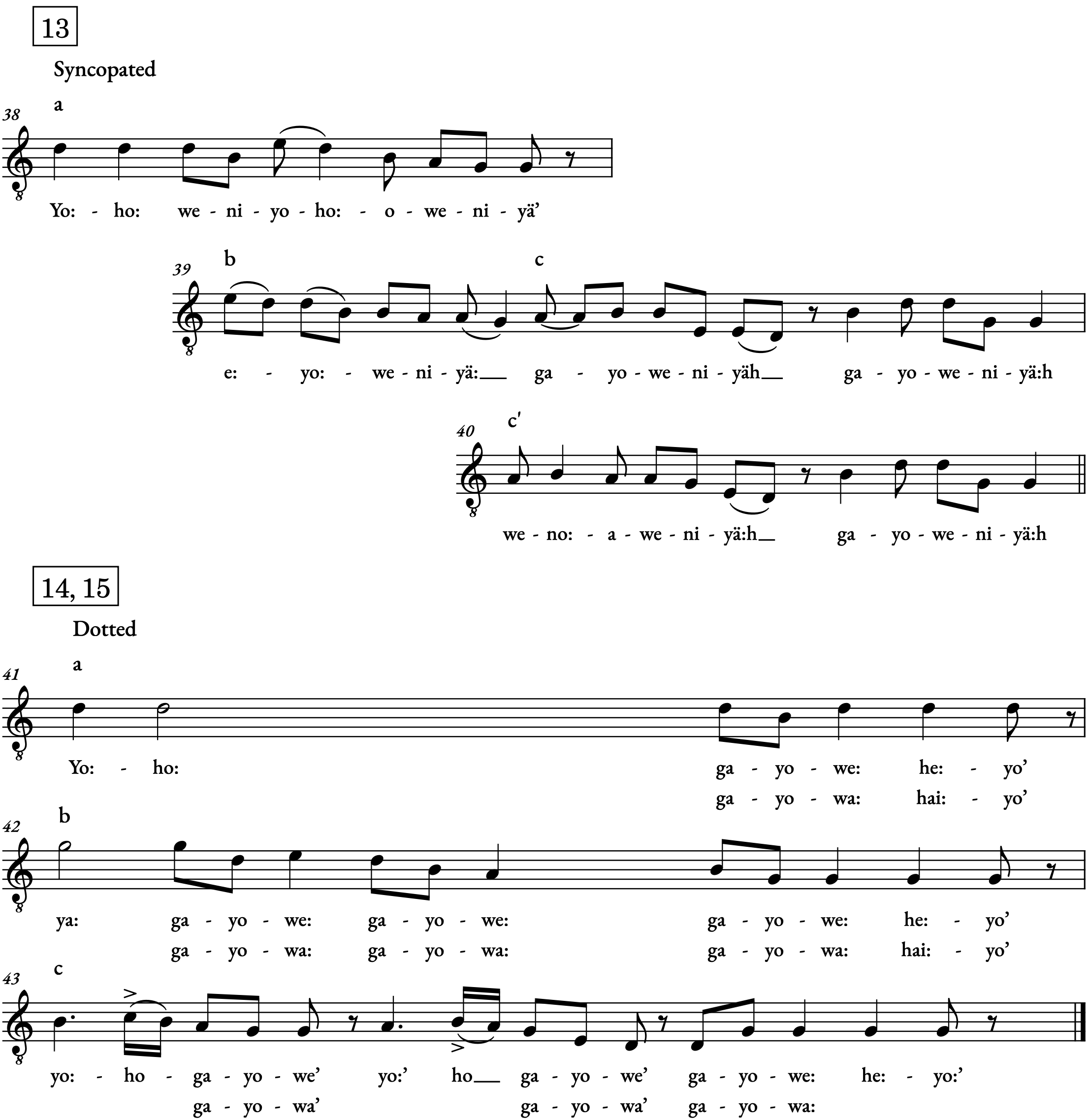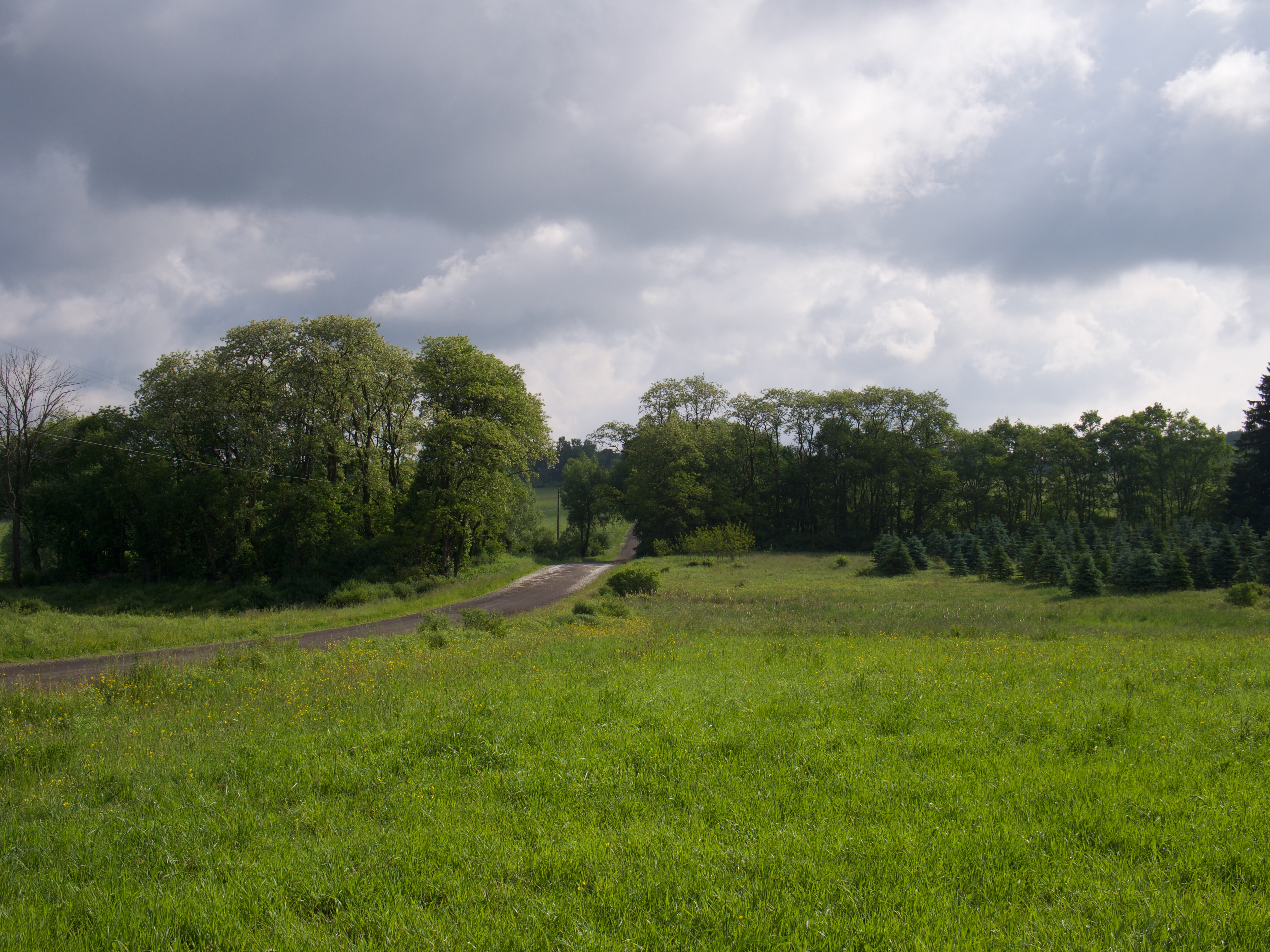Musical Patterns in Depth (Andrew)
Listening to the set of Gayó:waga:yöh songs recorded by the Allegany Singers (video 1), why do these songs can sound so varied and yet still seem to have a close family resemblance? They sound like they belong to the same dance even though there are different types of melodies and rhythms. This analysis explores musical patterns in Old Moccasin Dance and suggests some possible ways that these songs are related to each other, which might further point towards understanding how they were created.
I (Andrew) would stress that these are my own interpretations of what I hear. I am trying to listen in a way that is informed by Seneca worldview, and to avoid importing Western categories and methods, but I also believe that there is value in sharing my own way of hearing, as what I hope is the beginning of a discussion with others who may hear differently.
Melodic and Rhythmic Patterns
I hear recurring patterns of pitches, rhythms, and phrasing within each song and across the set, so that the individual songs seem to have been built in similar ways from a small set of musical ideas, and some of those musical ideas recur in other songs. One common thread is that all the songs draw from the same set of pitches, like a limited palette of colors in visual art. These songs are consistently diatonic, with most songs using six notes of the major scale (i.e., a major hexachord) and a few adding ♭̂7 as well (table 1).
| Pitch | 0 | 1 | 2 | 3 | 4 | 5 | 6 | 7 | 8 | 9 | 10 | 11 | |
|---|---|---|---|---|---|---|---|---|---|---|---|---|---|
| G | G♯ | A | B♭ | B | C | C♯ | D | D♯ | E | F | F♯ | ||
| Song | 1 | ■ | ■ | ■ | ■ | ■ | ■ | ||||||
| 2 | ■ | ■ | ■ | ■ | ■ | ■ | |||||||
| 3 | ■ | ■ | ■ | ■ | ■ | ■ | ■ | ||||||
| 4 | ■ | ■ | ■ | ■ | ■ | ■ | ■ | ||||||
| 5 | ■ | ■ | ■ | ■ | ■ | ■ | |||||||
| 6 | ■ | ■ | ■ | ■ | ■ | ■ | |||||||
| 7 | ■ | ■ | ■ | ■ | ■ | ||||||||
| 8 | ■ | ■ | ■ | ■ | ■ | ||||||||
| 9 | ■ | ■ | ■ | ■ | ■ | ■ | ■ | ||||||
| 10 | ■ | ■ | ■ | ■ | ■ | ■ | ■ | ||||||
| 11 | ■ | ■ | ■ | ■ | ■ | ■ | |||||||
| 12 | ■ | ■ | ■ | ■ | ■ | ■ | |||||||
| 13 | ■ | ■ | ■ | ■ | ■ | ■ | |||||||
| 14 | ■ | ■ | ■ | ■ | ■ | ■ | |||||||
| 15 | ■ | ■ | ■ | ■ | ■ | ■ |
The songs are similar not just in the general palette, though, but also in the process
by which they build on small rhythmic and melodic patterns.
Repeated vocables highlight repeated musical elements.
The refrain of the first song, for example, consists of just the vocable we:hanayöge:h repeated four times.
Each of those times makes up one of the four phrases in the refrain.
All four phrases have the same basic rhythm matching with the word:
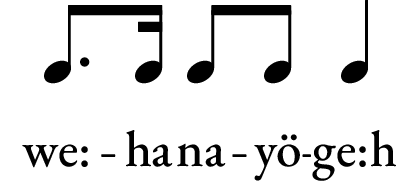 .
.
Similarly, in song 2
(music example 1),
the words repeat wenoyane with different accents and lengths.
The basic rhythmic motive is 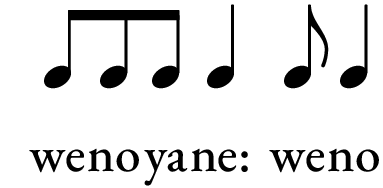 , which recurs at the beginning of the first phrase and the end of the other three.
This motive is syncopated against the underlying duple pulse played by rattle and
drum, and in relation to the strong emphasis on the long notes of
, which recurs at the beginning of the first phrase and the end of the other three.
This motive is syncopated against the underlying duple pulse played by rattle and
drum, and in relation to the strong emphasis on the long notes of 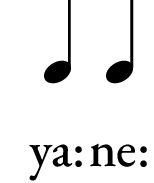 .
Even though songs 1 and 2 are built from different rhythmic motives, then, they use
those motives in similar ways.
Melodically, both of the first two songs trace a basic melodic outline B–A–G (mi–re–do).
.
Even though songs 1 and 2 are built from different rhythmic motives, then, they use
those motives in similar ways.
Melodically, both of the first two songs trace a basic melodic outline B–A–G (mi–re–do).

The rhythmic patterns in songs 1 and 2 recur in the rest of the songs. I hear every song in this set as a variation on either the dotted, duple eighth-note pattern of song 1, or the syncopated quarter-eighth-quarter rhythm of song 2 (table 2). There are also characteristic patterns at the ends of phrases, which mostly coincide with the other two patterns.
| Label | Main Pattern | Phrase Ending |
|---|---|---|
| Dotted | 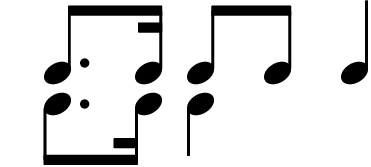 |
 |
| Syncopated | 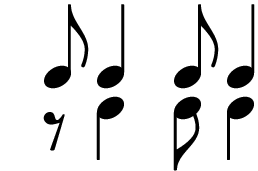 |
 |
| Tresillo |  |
 |
| Song | Beginning |
|---|---|
| 1 | 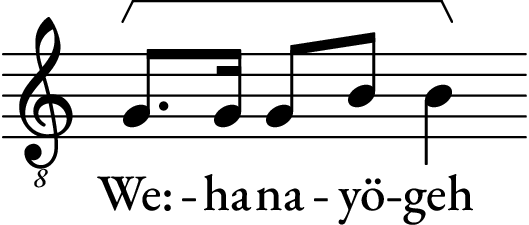 |
| 7 |  |
| 8 |  |
| 12 |  |
| 14 |  |
| 15 |  |
| Song | Beginning |
|---|---|
| 2 |  |
| 2 |  |
| 3 |  |
| 4 |  |
| 5 |  |
| 6 |  |
| 9 |  |
| 11 |  |
| 13 |  [...]
[...]
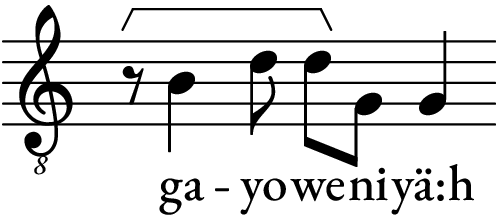 |
| Song | Beginning |
|---|---|
| 10 |  |
At first song 10 seems distinct from all the others, with its fast syncopated rhythm like a Caribbean tresillo with 3+3+2 groups of sixteenth notes. Its long-short-short ending pattern is also unique. Bill says that Kyle Dowdy learned this song from singers of Six Nations, Ontario, and thinks it does not fit as well with the other songs. The Allegany Singers did not include this one in their more recent recording. While acknowledging the different style of this song, I hear this rhythm as a highly elaborated version of the Syncopated pattern from song 2 (music example 2).

Phrase Structures
Finally, as we noted in the first two songs, the phrases in each song are built from limited musical elements, and we can also identify two basic patterns of phrase structure across the set. These songs have either three or four phrases. In some of those with four phrases, the last phrase is unique (making an ABCD pattern), whereas in the others, it is a repetition of the second or third phrase (ABCB or ABCC; table 6). The phrases contrast but also echo each other, with small motives repeated or varied in subsequent phrases, as can be seen graphically by separating the phrases and aligning the similar ideas (music example 3). Songs 7 and 8 provide an example of how the same musical ingredients can be mixed together into different phrase structures. Song 8 has a relatively simple structure of ABCB, while in song 7 the first B phrase is extended and there is no C phrase.
| Type | Pattern | Songs |
|---|---|---|
| 3 distinct | ABC | 9, 10, 11, 14, 15 |
| 4 distinct | ABCD | 1, 3, 4, 5, 6, 13 |
| 4, last repeated | ABCB | 7, 8 |
| ABCC | 2, 12 |
